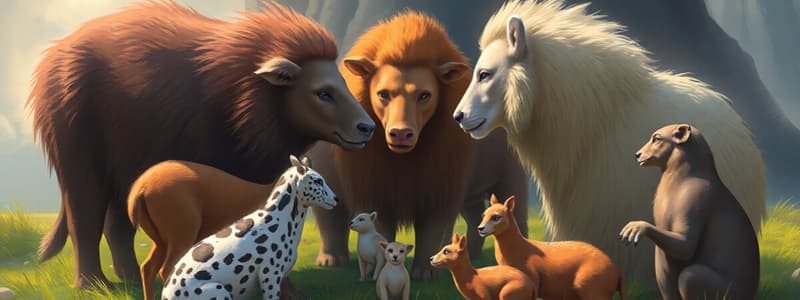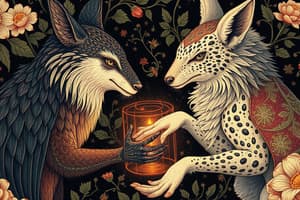Podcast
Questions and Answers
What does Hamilton's Rule state regarding altruism?
What does Hamilton's Rule state regarding altruism?
- The relationship coefficient multiplied by the benefit to the recipient must exceed the cost to the donor. (correct)
- The benefits to the recipient are always greater than costs to the donor.
- Altruism is mainly driven by external environmental factors.
- Altruism only occurs among unrelated individuals.
Which of the following is NOT a characteristic of eusociality?
Which of the following is NOT a characteristic of eusociality?
- Isolation of individuals from their kin. (correct)
- Multiple adults living together.
- A single reproductive individual in the group.
- Cooperation in brood care.
Which statement about haplodiploidy is true?
Which statement about haplodiploidy is true?
- Males are diploid and females are haploid.
- Sisters share 50% of their genes on average.
- Sisters share 75% of their genes with each other. (correct)
- All offspring are genetically identical.
What is an Evolutionarily Stable Strategy (ESS) according to game theory?
What is an Evolutionarily Stable Strategy (ESS) according to game theory?
What defines social behavior among individuals of the same species?
What defines social behavior among individuals of the same species?
In the context of kin selection, which of the following is an accurate description of altruism?
In the context of kin selection, which of the following is an accurate description of altruism?
What tactic describes a 'Hawk' in the context of game theory?
What tactic describes a 'Hawk' in the context of game theory?
What is a potential disadvantage of living in social groups?
What is a potential disadvantage of living in social groups?
What does the term 'inclusive fitness' refer to?
What does the term 'inclusive fitness' refer to?
What does reciprocal altruism typically involve?
What does reciprocal altruism typically involve?
Kin selection is often explained through which concept?
Kin selection is often explained through which concept?
Which factor is essential for the evolution of altruistic behaviors?
Which factor is essential for the evolution of altruistic behaviors?
Territoriality generally involves which behavior of individuals?
Territoriality generally involves which behavior of individuals?
What is the main question addressed in a cost-benefit analysis of social interactions?
What is the main question addressed in a cost-benefit analysis of social interactions?
Which of the following is NOT a component of social groups?
Which of the following is NOT a component of social groups?
Flashcards
Social Behavior
Social Behavior
Any interactions between individuals of the same species.
Social Groups
Social Groups
Prolonged aggregations of individuals of the same species.
Family Groups
Family Groups
Related individuals where offspring interact with parents into adulthood.
Selfishness (in animals)
Selfishness (in animals)
Signup and view all the flashcards
Altruism
Altruism
Signup and view all the flashcards
Kin Selection
Kin Selection
Signup and view all the flashcards
Inclusive Fitness
Inclusive Fitness
Signup and view all the flashcards
Relatedness (in evolution)
Relatedness (in evolution)
Signup and view all the flashcards
Hamilton's Rule
Hamilton's Rule
Signup and view all the flashcards
Eusociality
Eusociality
Signup and view all the flashcards
Haplodiploidy
Haplodiploidy
Signup and view all the flashcards
Reciprocal Altruism
Reciprocal Altruism
Signup and view all the flashcards
Evolutionary Stable Strategy (ESS)
Evolutionary Stable Strategy (ESS)
Signup and view all the flashcards
Game Theory
Game Theory
Signup and view all the flashcards
Study Notes
Social Behavior
- Social behavior is any interaction between individuals of the same species
- Continued group interactions include social groups (prolonged aggregations of individuals of the same species) and family groups (related individuals where offspring interact with parents into adulthood)
Social Groups
- Living in a group has advantages and disadvantages
- Example of animals that live in groups are European goldfinches and sharp-shinned hawks
Vigilance
- The amount of head jerks per minute (vigilance) of a bird increases as the size of the bird flock increases
- As flock size increases, birds spend more time looking for predators
Feeding Time
- Handling time decreases as flock size increases
- The flight interval time increases as flock size increases
Cost-Benefit Analysis
- Used to determine if social interactions in a population should evolve
- Interactions are analyzed based on costs to a donor, benefits to a recipient and relatedness (r).
Interactions within Species
- Various interactions are displayed in an interaction matrix. Positive, negative, altruism, cooperation, selfishness and spitefulness are some examples.
Selfishness
- Territoriality: defending resources from other individuals (of the same or other species)
Mate Choice and Mate Competition
- Males defend territories with food 2-5x larger than needed
- Mating success depends on nectar content in territories
Altruism
- Altruism reduces fitness but may evolve through kin selection
Kin Selection
- Inclusive fitness = fitness of an individual plus fitness of relatives
- Kin selection describes an interaction that depends on the cost to the donor, benefits to the recipient and relatedness.
- Relatedness refers to genetic similarity which can be quantified by the coefficient of relationship (r)
Altruism through Kin Selection
- Behaviors are possibly widespread among family groups
- Limited dispersion increases relatedness
- Individuals can sense relatedness through chemical or behavioral cues which may not require prior experience.
Adopting Kin
- Red squirrels defend territories through vocalizations
- Adoption often happens between kin (5 of 2230 litters)
Kin Selection and Cooperative Courtship in Wild Turkeys
- Data is provided from a study investigating Kin Selection and cooperative courtship in wild turkeys.
- Data includes relatedness coefficient of subordinate and dominant male pairings.
Kin Selection and Selfishness
- The mean age (days) at which predatory morphology develops is correlated with the concept of kin selection and selfishness.
Insect Societies
- Eusociality involves multiple adults living together, and cooperation in nest building and brood care
- Reproductive dominance is held by one or few individuals and sterile castes of daughters are commonly observed (=altruism)
- Ants, bees, and wasps (Hymenoptera) and termites (Isoptera) are examples
Haplodiploidy
- Males are haploid, while females are diploid
- Sisters share 75% of genes
Will Altruism Evolve among Unrelated Individuals?
- This questions whether altruism would evolve among unrelated individuals.
Reciprocal Altruism
- Blood meals and vampire bats are analyzed for instances of reciprocal altruism.
Will Cooperation or Selfishness Evolve More Frequently?
- The question of whether cooperation or selfishness evolves more frequently is analyzed by various researchers
Game Theory
- Game theory is used to determine the optimal strategy of decision-making among interacting individuals considering costs and benefits
- Evolutionarily Stable Strategy (ESS) refers to the optimal strategy which will evolve and will not be 'invaded' by other strategies.
Game Theory: Hawks and Doves
- Hawks are selfish and fight always for resources
- Dove tactics are cooperative and share resources evenly
Average Payoff per Interaction
- The payoff to hawks always exceeds that to doves
- Calculations are often used to estimate which interaction are beneficial.
Evolutionary Stable Strategy (ESS)
- A society of all hawks is an ESS strategy. However, mixed strategy is often evolutionary stable.
- Cost varying strategies also need to be looked at.
Higher Cost
- When cost is greater, then mixed strategy of hawks and doves is often evolutionary stable.
Studying That Suits You
Use AI to generate personalized quizzes and flashcards to suit your learning preferences.




